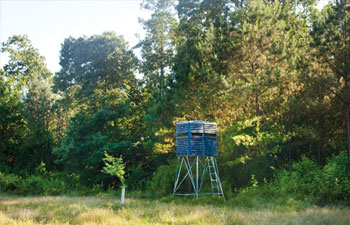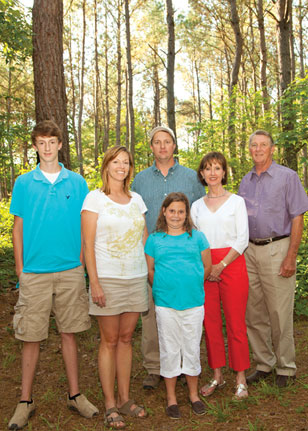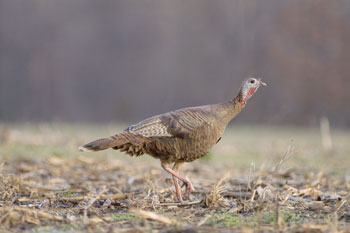
Ronnie Young stands in a road he and his son, Neil, cut through hundreds of acres of loblolly pines, which they thinned to allow more room to grow and more plants that feed wildlife.
Photo by Debra Ferguson/Southern Images
The afternoon sun is edging high in the sky as Ronnie Young drives Mississippi Land Bank loan officers Joe Hill and Matthew Raff through the network of roads that wind through his rural property near Holly Springs, Miss. Deer scamper into the stands of tall timber, and down the road, a flock of turkeys casually strolls through a clearing.
“You really don’t have to get up at 4 in the morning to hunt turkey here,” Hill says.
Ronnie’s got them trained to sleep in.”
But even if he does have to rise early for a glimpse of the toms’ vivid blue heads and red wattles, Ronnie says it’s worth it. “Early in the morning, it looks like a snow cone coming through the woods,” he says.
A Love of the Outdoors
For Ronnie and his son, Neil, a love of the outdoors is a family tradition, and they have devoted the past eight years to improving this property and managing for wildlife.
“My dad took me hunting and fishing from a very early age, and since Neil was barely able to walk, I’ve taken him with me. It’s been the same with his son,” says Ronnie, who lives in Hernando, Miss. “It created a deep and abiding love of the land.”
So when Ronnie was ready to retire from the family’s pest control company, he and Neil looked for about 1,000 acres for recreation and hunting. They hoped to find a mix of woods, water and open land and a way to earn income to offset expenses. After a few years, they found it all in two adjacent farms near Holly Springs, which they financed with Mississippi Land Bank.
In 2004, Ronnie turned the business over to his son, and they also became partners in Piney Ridge Farms.
A Gathering Place

Three generations of Youngs use Piney Ridge Farms for hunting and recreation. From left are Wesley, his mother Gwyn, her husband Neil, their daughter Elaine, and Neil’s parents Pat and Ronnie.
Photo by Debra Ferguson/Southern Images
Three generations of the Young family have regularly made the 40-minute trip here ever since. Ronnie’s wife, Pat, a former reporter and journalism teacher who helped run the family business, says a typical visit starts with a big breakfast before everyone goes hunting. “Then later, the kids will change clothes and play football or soccer.”
The years are manifested in rows of tassel-like turkey beards that line one wall of the metal building where the family gathers. Nearby, bulletin boards are covered with photos of Neil and wife Gwyn’s children, Wesley and Elaine, and their friends hunting, four-wheeling and holding birthday parties. Ronnie and Pat’s daughter, Lesley, a freelance writer in Florida, also visits when she can.
Sharing a Good Thing
But the Youngs don’t believe in keeping a good thing to themselves. They welcome up to 150 youths to Piney Ridge for forestry field days, and host tree-thinning workshops for the Marshall County Forestry Association — the state’s largest — where Ronnie is vice president and president-elect. And for a few months between hunting seasons, dogs that assist law enforcement agencies in northern Mississippi and the Memphis area use the farm to practice searching for people on land and in water.
“We look for realistic places to train,” says Judy Otto, training director for the Mid-South Search and Rescue Dog Association. “Often we end up in brush and briars, but the Youngs’ place is structured so nicely. It has broad avenues of grassy plains between woods, and several ponds. It’s very diverse.”
A Change in Scenery
That diversity is what attracted the Youngs, but the Piney Ridge Farms of today reflects eight years of work — and homework. As a part-time land agent, Ronnie knows recreational property, but he had to educate himself about managing timber and cropland through books and resources at government agencies and from his lender, Mississippi Land Bank.
“One thing I’ve learned is to just start asking questions,” he says. That’s how he discovered conservation programs that can help create wildlife habitat, finance improvements and provide some income.
The Youngs started by bulldozing roads through 300 acres of dense pines, planting the paths in clover to double as food plots. They then thinned the pines for the first time in 20 years and conducted two prescribed burns, which gave the trees room to grow and encouraged plants that support wildlife.
In the cropland, they enrolled 90 feet on either side of a creek in a Farm Service Agency riparian buffer program, which covered most of the cost to plant oaks to stabilize the sandy soil. They also rebuilt eroded banks and installed berms and pipes, known as drop inlets, to slow runoff.
“The conservation practices he has implemented on 1,000 acres, on fragile soils, is just textbook what the biologists recommend.”– Matthew Raff, Mississippi Land Bank
Wondering what to take on next, in 2008 they called John Gruchy, a private lands wildlife biologist for the Mississippi Department of Wildlife, Fisheries and Parks. That marked a turning point for the farm.
Encouraging Quail
“Marshall County has a great quail heritage, and once had abundant quail populations,” says Gruchy. “It is very close to the Ames Plantation, where they do the National Field Trials Championships.”
Gruchy often consults with nearby landowners such as another Mississippi Land Bank customer, Dr. Thomas Morgan, who raises bird dogs just a few farms away at Covey Rise Plantation. Gruchy says he likes to see adjacent landowners create a “critical mass” of wildlife habitat that adds up to 2,000 to 5,000 acres, and the Youngs were in the perfect spot. If the avid turkey hunters were willing to replace their crops with native warm-season grasses for 10 to 15 years, they could take advantage of a conservation quail program known as CP-38 that would also encourage turkey and songbirds.
“During my first tour, Ronnie said, ‘I haven’t seen quail on this farm since I bought it.’ Just as he did, we broke up a brood in a clover patch,” Gruchy says. “By putting down native grass, he is able to manage for wildlife and get paid an annual rental rate to take the ground out of production.”
A Wildlife Haven
“We could have made more farming, but that was not our main goal,” says Ronnie. He and Neil replaced 270 acres of corn and soybeans with big and little bluestem and Indian grass that provide cover and nesting habitat. Crossing the fields are rows of young trees that create wildlife corridors and 30-foot-wide firebreaks that make it easier to burn a third of the fields each year.
Wildlife feed on clover in the firebreaks, on insects in the grasses, and on apples, pears, plums, persimmons and loquats in four orchards. Someday, they’ll also have acorns from oaks descended from those in the Grove at Ole Miss, Neil’s alma mater. During last summer’s searing heat, Ronnie hauled water in five-gallon buckets to acres of young trees.
“Ronnie has had a bump in turkey population, and I expect he’ll see a bump in quail in the next two to three years,” Gruchy says. Already, Ronnie spotted a covey of 15 quail last fall, and dozens of songbird species have been documented at the farm by Mississippi State University.

Eastern turkey are among the most abundant wildlife at the farm.
Photo by Bryan Eastham/Shutterstock.com
Better Habitat, Better Value
Hill and Raff, vice presidents at Mississippi Land Bank’s Senatobia branch who helped the Youngs find and finance the property, are impressed with the changes.
“This is a completely different place than it was when we were here in 2004,” says Raff, who is also a registered forester. “Ronnie has turned it into an ideal wildlife project, and in doing so has increased its value.
“The conservation practices he has implemented on 1,000 acres, on fragile soils, is just textbook what the biologists recommend,” Raff says.
Leaving the farm in better shape for future generations has won the Youngs some recognition. In 2008, the USDA Natural Resources Conservation Service named Ronnie the Outstanding Conservationist of the Year for Marshall County, and in 2010 the Marshall County Forestry Association named him County Tree Farmer of the Year.
“Very few landowners commit to the level that Ronnie and Dr. Morgan have,” says Gruchy. “They’re the ones that go above and beyond.”
– Staff
A Burning Desire to Encourage Wildlife
Debra Ferguson/Southern Images
Fields of native grasses and forbs are surrounded by pine and hardwood forests. Near a hunting blind is a young fruit tree, one of dozens the Youngs have planted.
Back when bobwhite quail were common in the South, fire was a normal part of the cycle of nature and of land management.
“At some point there was going to be fire on the landscape,” says wildlife biologist John Gruchy. “Now, nobody burns. But fire is critical.”
Fire not only makes nutrients available to a new generation of plants but also controls woody growth. Without it, he says, land in the Southeast would naturally revert to forests.
“Fire keeps growth in the grass and desirable forbs, or plant communities that benefit deer, turkey and quail,” he says.
Until recently, Mississippians either had to conduct burns themselves or pay up to $30 an acre to hire a professional. That changed last year when Marshall County landowners and the Strawberry Plains Audubon Society in Holly Springs formed the Coldwater Prescribed Burn Association, the first such group in the Southeast.
Now about 35 members, including Joe Hill and Matthew Raff of Mississippi Land Bank, share equipment, a group insurance policy and a certified burn manager as they conduct burns for each other for free. Ronnie Young, who is on the association’s advisory board, plans to use the group’s services on his grasslands every year.
“I think the Coldwater association is a perfect example of landowners working together to form a cooperative,” says Gruchy. “For habitat, that’s a very new concept to share resources.”